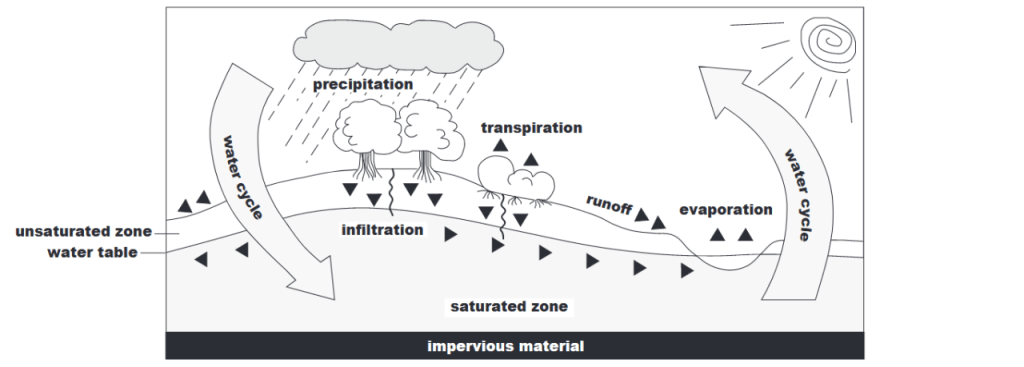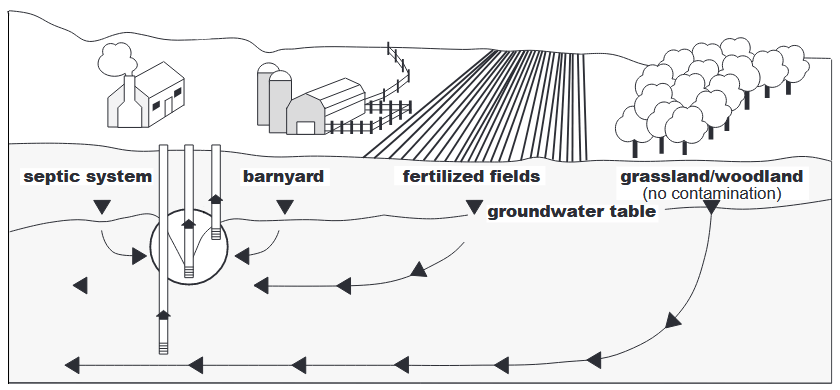How deep should my well be? It is nearly impossible to know the ideal depth of a well before you install it. If you have neighbors, learning the depth of their wells and the corresponding water quality may give you a better understanding of where your new well’s depth will land at. A good rule of thumb for well construction is “as shallow as possible, as deep as necessary”. This is keeping in mind that well code regulations and requirements still need to be followed.
Wisconsin’s groundwater does not come from underground rivers, Lake Superior or Canada. Groundwater starts as precipitation that soaks into the ground, usually within a few miles of your well. That is to say, well water in Waupaca, Waushara, Portage, and other counties comes from the sky. Groundwater is part of nature’s water cycle.

The unsaturated zone forms the upper layer of soil. Pulled downward by gravity, the water in this zone moves slowly through pores in the soil, some of which also contain air. Below the unsaturated zone is the saturated zone, where all the pores between the sand grains and gravel particles are filled with water. The boundary between the saturated and unsaturated zones is called the water table. Water in the saturated zone, below the water table, is called groundwater.

Human activities and various land uses, such as septic systems, barnyards or fertilized fields, may contribute to groundwater contamination. Gravity pulls water that soaks into the ground under these areas almost straight down to the water table. Contaminants may be dissolved and carried along as well. The soil filters out some of these materials, but may not be able to remove them all.
There are good reasons why you might want a deep well.
If you install a deeper well, your water quality will be influenced by land uses farther uphill from you in the groundwater flow system. The water that you draw from a deeper well is likely to be older, having been in the ground for a longer time than water from a shallow well. This fact has some points to consider:
- The water quality in a deep well may reflect land uses of ten or more years ago. If a landfill a mile uphill leaks, it could take many years for the contaminants to show up in your deep well.
- Water quality in a deep well usually changes more slowly than in a shallow well. A spill a mile away from your deep well in the sand and gravel aquifer might be substantially diluted with clean recharge water before it gets to your well.
- Some chemicals, such as pesticides or gasoline residues, break down or change over time. If a pesticide soaked into the ground a mile away from you, it might be substantially changed in the time it would take to reach your deep well.
- Water from deeper wells may be less corrosive than shallow well water. Shallow groundwater is often corrosive because the natural minerals which could protect against corrosion are depleted in the shallow parts of the aquifer. Corrosive water can damage metal, causing copper pipes to leak. When water is corrosive, lead solder (not allowed after 1984) that joins copper pipes can dissolve and enter drinking water at unsafe levels.
There are also good reasons why you might want a shallow well.
Water in deeper wells is older which gives it some benefits. This can also lead to significant problems.
- Minerals that dissolve in water such as calcium and magnesium (which cause hardness) are more plentiful deeper in the aquifer. Also, as the aquifer gets deeper, the amount of oxygen decreases. This makes it easier for certain minerals like iron and manganese to dissolve.
- Deeper wells generally possess higher levels of naturally occurring radioactivity than shallow wells, especially when they come in contact with the crystalline bedrock aquifer underneath sand and gravel. However, some shallow wells have also been affected, especially where the local sand and gravel is composed of crystalline rock particles.
- If you live in a sparsely populated non-agricultural area, and have control over land uses up-gradient, or uphill, in the groundwater flow system, installing a shallow well allows you to maximize control of your own drinking water quality.
How Deep Should My Well be? There is no simple answer.

Determining the best well depth is not an easy matter. Also, if land uses change, a well that once produced good quality water could become contaminated. Looking at the direction of groundwater flow, the surrounding land uses, any existing groundwater contamination, and the natural quality of groundwater in the area will all help to choose a drilled well depth that will provide the best quality water for you and your family.
